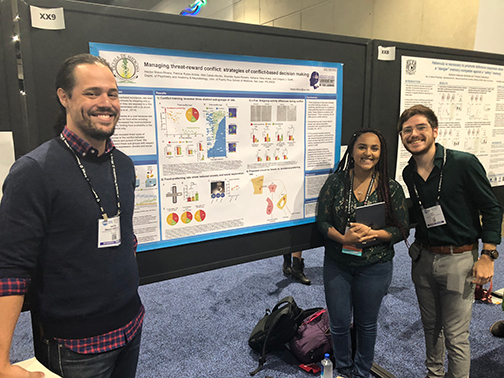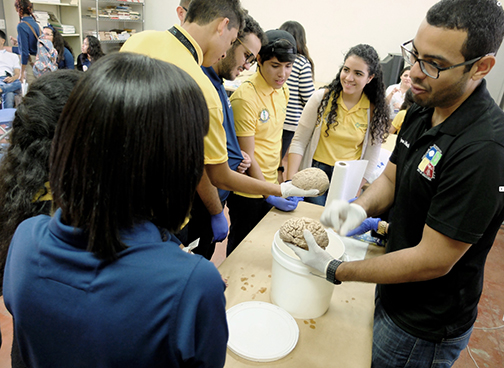Archived Content
The National Institute of Mental Health archives materials that are over 4 years old and no longer being updated. The content on this page is provided for historical reference purposes only and may not reflect current knowledge or information.
Puerto Rico’s “Fear Lab” Mentors Neuroscience Rigor amid Diversity
Journal club, lab meets, one-on-ones and mountain retreats forge common bond
• Press Release
A lineage of young neuroscientists from diverse backgrounds trace their scientific roots to a “fear lab” in Puerto Rico that the National Institutes of Health has been supporting for two decades. A crucible for studies of fear extinction, the lab has so far published 80 papers—some the first ever from Puerto Rico for certain journals—that generate more than 2,000 citations a year. Of 130 young people trained in the lab, 90 percent are from Puerto Rico and Latin America and half are women.
“Like most labs, the key has been fostering intellectual growth through journal clubs, lab meetings, weekly one-on-ones, and philosophy of science retreats,” said the lab’s founding director, Gregory Quirk, Ph.D. “Done right, these four activities develop skills of logic, communication, and intellectual inquisitiveness in trainees while also building group cohesiveness.”
After completing a post-doc fellowship at New York University, New York City, under well-known fear researcher Joseph LeDoux, Ph.D., Quirk launched the lab in 1997 at what is now Ponce Health Science University, Ponce, Puerto Rico. A decade later, it moved to its current location at the University of Puerto Rico Medical School in San Juan, adding some human and non-human primate studies.
Quirk provides tips on his approach to nurturing discovery and mentoring “off the beaten track” in an article published Jan. 30, 2018 in the Journal of Neuroscience. It marks nearly two decades since the lab’s first publication in that journal, which showed that ventral medial prefrontal cortex was necessary for consolidation of extinction (loss of fear) memory in rodents.
Soon thereafter, the group made news when it reported in Nature that they had discovered the brain’s equivalent of an “all clear” signal in the infralimbic cortex, that when mimicked with electrical stimulation, quelled conditioned fear in rats. Since then, the lab has been in the vanguard of translational studies extending insights from extinction learning experiments to mental disorders.
For example, in 2015 they reported in Nature a discovery of possible relevance to post traumatic stress disorder (PTSD)—that an old fear memory is recalled by a separate brain pathway from the one originally used to recall it when it was fresh.
“More recently, my laboratory has explored circuits of active avoidance, obsessive-compulsive disorder, and frustration using deep-brain stimulation, optogenetics, and CRISPR-Cas9 techniques,” Quirk added.
He credits support from NIH’s National Institute of Mental Health (NIMH) as a key to the lab’s success. For example, a FIRST Award from NIMH was renewed four times. The lab was also the first in Puerto Rico to receive a Presidential Early Career Award and a MERIT Award.
“Other grant ‘firsts’ for Puerto Rico were a CONTE Center P50 subaward, a Pathway to Independence Award (K99-R00) for my postdoc, and Dissertation Completion Awards (R36) for my graduate students – all funded by NIMH,” noted Quirk.
Quirk’s report includes comments from former trainees, which he collected during a recent reunion celebrating the lab’s 20th anniversary. For example, “After years of JClubs, you are never again satisfied with mediocre efforts,” a former doctoral student commented about the lab’s mandatory journal clubs.
Weekly lab meetings begun with guided meditation and “appreciations” set a tone that fosters a culture of cooperation, said Quirk. Rotating presentations by trainees ensure that everyone knows what each person is doing/thinking in the lab and can help guide it.
“It was impressive when I found a Quirk Lab member presenting another member’s poster without being part of the study: lab meetings turned every member into defenders of the others’ projects,” observed a former student.
Lab members are encouraged to overcome any inclination to be socially polite and boldly ask questions of each other, Quirk said. The same high standard is expected in written communication. A “Six-Eyes Rule” dictates that manuscripts be critiqued by three outside readers before submission to a journal.
“You are writing for a brain that is not yours,” he noted.
The idea to have what Quirk affectionately calls “Face Time” – individual one-on-one meetings – originated with students. “This was a firm deadline to make my data presentable and remind Greg of the importance of my project,” said one current post-doc.
For three days each winter, the lab uses university funds to head the mountains for a Philosophy of Science Retreat. “Rather than discuss data, the idea of the retreats is to examine the philosophical issues that define us as scientists and underlie our approach to scientific questions,” explains Quirk.
“The retreat gave me the security to rely on the other people in the lab,” noted a current undergraduate. Each grad student or post-doc mentors two to four undergraduates.
In a recent NIMH Director’s Message spotlighting fear lab trainees at last year’s Society for Neuroscience Meeting, NIMH director Joshua A Gordon, M.D., Ph.D., wrote: “Dr. Quirk is a long-time NIMH grantee who has been a supportive and effective mentor, training numerous undergraduate and graduate students who have gone on to stellar neuroscience careers.”

Trainees Héctor Bravo-Rivera, Shantée Ayala-Rosario, and Albit Cabán-Murillo, of Puerto Rico’s “fear lab,” presented a poster on decision-making under conditions of threat at last year’s Society for Neuroscience meeting.

Trainees examine brain.
Source: Quirk Lab, University of Puerto Rico School of Medicine
Reference
Quirk GJ. Neuroscience research and mentoring in Puerto Rico: what succeeds in this environment? jneurosci, Jan 30, 2019. Doi:10.1523/jneurosci.2352-18.2018.
Grants: MH058883 , MH106435 , MD0007600
About the National Institute of Mental Health (NIMH): The mission of the NIMH is to transform the understanding and treatment of mental illnesses through basic and clinical research, paving the way for prevention, recovery and cure. For more information, visit the NIMH website.
About the National Institutes of Health (NIH): NIH, the nation's medical research agency, includes 27 Institutes and Centers and is a component of the U.S. Department of Health and Human Services. NIH is the primary federal agency conducting and supporting basic, clinical, and translational medical research, and is investigating the causes, treatments, and cures for both common and rare diseases. For more information about NIH and its programs, visit the NIH website .
NIH…Turning Discovery Into Health®
